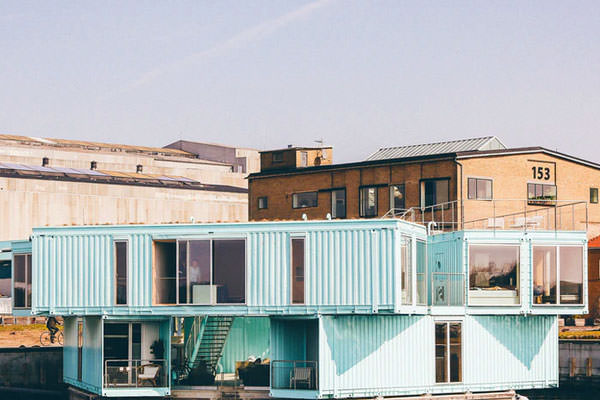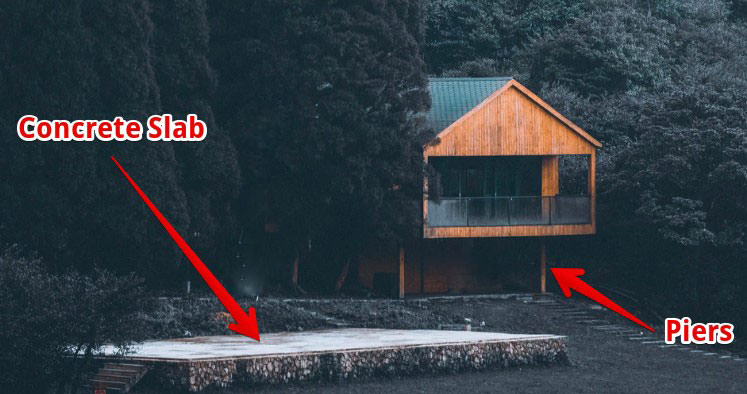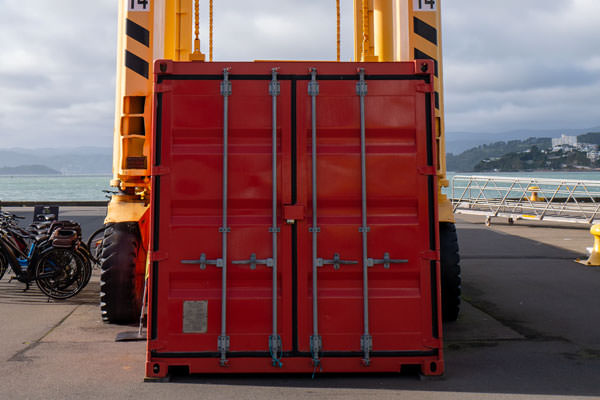
If you have been looking for a cheap alternative, you may wonder; can you build a granny flat from a shipping container?
Yes – a shipping container can be approved as a granny flat. To be legally approved, it must be changed from a movable dwelling into a permanent, “habitable”, building. This involves making modifications such as adding doors, windows, appliances, plumbing, insulation, etc.
Today I will discuss how to legally build a shipping container granny flat. I will cover the nasty traps to avoid when building with shipping containers. Provide information on the best designs for shipping container cabins, plus a whole lot more.
DON'T PAY A FORTUNE FOR YOUR GRANNY FLAT. Find out how to deal with council and build a granny flat for the lowest cost possible. Learn More.
With all of this content to cover, lets begin.
How to Build a Shipping Container Granny Flat
There can sometimes be more steps involved in building a shipping container granny flat than a traditional granny flat.
- Do Your Research – This is always the first and most important step – contact your local Council and find out your regulations.

Preliminary research will save you a ton of headache before building
Whilst speaking to them, ask for a copy of your Section 10.7 Certificate, to learn the development restrictions on your property. You can also ask your Council what size your property must be, and the setbacks required for a granny flat.
If you live in NSW like I do, another hint is to enter the address of your property into the NSW Planning Portal. Here, you will find any planning constraints and zoning rules that you are affected by. It’s important to know whether your Council will approve a shipping container granny flat, as to not make plans just to be let down.
Start researching shipping containers – you must have a rough idea of what you want. There are many different types and sizes of shipping containers, and this article provides great advice as to what makes a good granny flat. Also, know whether it is possible to get a container onto your land. A local crane company will generally give you a free quote to check access to your site.
- Start Your Approval Process – Now you are armed full of knowledge, you can begin your paperwork.
For a shipping container granny flat, you only have one option for approval – usually a Development Approval. Contact your local Council for their regulations, the application forms, and all necessary paperwork that must be submitted with your application. You can do this in person or download them from their website.
- Enlist Help from Professionals – When applying for approval by a DA, you will need to hire professionals. Architects or drafters can provide you with drawings for your design. Structural Engineers will provide you with a report. And a surveyor will map out your land. All of this you will need for your plans.
- Have Your Plans Checked by a Certifier – Once your paperwork is ready, it’s time for someone to come give them the stamp of approval. You can choose from a private certifier or the local Council.
- Purchase Your Shipping Container – If you receive approval, you can now purchase your shipping container. It is important to have the knowledge before you purchase anything, so you don’t end up with an empty container sitting on your property.
- Start Building – You were granted your Construction Certificate when the certifier came over to check your plans. Now you can start building, making the modifications required so it is classified as “habitable”. It makes sense – you really do need doors, windows, fixtures, appliances, and plumbing in your granny flat.
- Get the Final Tick of Approval – Once your “building” is finished, the certifier will visit again, to check you followed the plans submitted. If they’re happy you completed the building legally, and it’s safe to live in, you will be given an Occupation Certificate. Your shipping container granny flat is now successfully approved!
Can You Legally Build a Container Home Granny Flat?
It is important to note that every local Council has their own rules regarding living in a shipping container. Most are similar – they will treat a permanent shipping container just as they would your backyard shed.
Though what’s important about shipping containers is that they are movable dwellings so are not classified as “buildings”, meaning:
- They CANNOT be approved by a Complying Development Certificate (CDC).
This means you must submit a Development Application to be legally allowed to reside in them.
As such, I suggest you contact your local Council for information on both their specific regulations and approval process.
In NSW, for example, you can only be approved for a granny flat shipping container by a Section 68 Application through your local Council. (The link just mentioned refers to the NSW Government).
The process for a Section 68 Application is much like the Development Application, meaning approval may be denied, if:
- Your neighbours object to the development, or
- Council finds the design unattractive.
This is quite common in prominent neighbourhoods if council believes the appearance of a shipping container does not suit the surrounding environment.
The good news is that if you are approved to build your shipping container granny flat through a Section 68 Approval;
- You have been granted your Construction Certificate, so can begin building immediately.
- It’s a relocatable home, so you won’t need a BASIX Certificate. This is verified by the NSW Department of Planning.
Granny Flat Shipping Containers – Nasty Traps to Avoid
Although shipping containers are ideal for building a granny flat, as with any building method they have their pitfalls.
So, it’s important you do your research first, to avoid these issues.
Here are common problems to look out for when building a shipping container granny flat.
- Do You Have Transit Insurance? – If anything goes wrong you will be left to pay for the damage. Insurance is essential in transport!
- Do They Comply with Your Local Councils’ Regulations? – As a granny flat, a shipping container will require approval from your local Council. In some areas they may not be allowed if they look ‘out of character‘. It’s important to contact your local Council and get all information on the approval process before purchasing your shipping container.
NOTE: All it takes is a few phone calls – don’t miss this vital step. If you do, you may find yourself buying something you’re not allowed to use.
- Have You Chosen the Correct Container? – Especially important is the type and size of container. Some are perfect for granny flats, some probably won’t be approved. For example, a high cube container may be too tall for your local council.
Best Designs for Shipping Container Cabins
With shipping containers, your options for design are endless, as you can combine them together until you reach your maximum floor space. They can also work on any complex site.

This elaborate home in Denmark could serve as inspiration.
Examples of all sorts of different design options can be seen at Container Homes.
Turning a Shipping Container into a Granny Flat – What Needs to be Done
A shipping container needs modifications before it is classified as a “habitable area“.
This includes adding:
- Doors.
- Windows.
- Internal walls.
- Ventilation.
- Fixtures (i.e. lighting, shelving, wardrobes, bench-tops, flooring, etc).
- Appliances (i.e. a hot-water system, oven, washing machine, etc).
- Plumbing, draining and sewerage.
- Electrical connections.
- Insulation.
This is required as part of Council approval, to turn what was a transportable dwelling, into a permanent building.
However, with every modification, you do risk making the shipping container weaker. Though shipping containers are designed to be strong, they aren’t designed to be cut and re-joined several times. So, only cut them when you need to. While they are flexible in their design, they will need to be sufficiently reinforced to ensure they remain structurally sound.

Welding and cuts should be done by a professional
All welding must be performed by a professional, and all cut outs must be approved by a structural engineer. This ensures your shipping container granny flat remains safe.
Shipping Container Granny Flat Costs
A lot of people opt for a shipping container granny flat, as they can be cost effective.
While the containers themselves cost roughly $5000 (depending on their size), don’t forget about the additional costs.
Expect to spend a quite a lot of time and money before your shipping container qualifies as “habitable”.
These extra costs include:
- Certificates, Council approval and fees.
- A surveyors report.
- Modifications.
- Architect or drafts person.
- An engineers report.
- A foundation.
- Transport.
- If you intend on building yourself – a course to get your “owner-builder” certificate.
- A licensed plumber.
- An electrician.
- A certifier (private or local Council).
- Labour (if outsourced).
- Waste removal.
- Landscaping.
For a thorough breakdown of these costs, you can read exactly what I paid when building my granny flat.
Please note: The costs do vary significantly between Councils’, so I’ve only provided information on what I paid.
However, if you set a budget and keep things simple, it’s possible to build a shipping container granny flat for under $20 000.
How Do You Relocate a Shipping Container Granny Flat?
A shipping container requires preparation for transportation. Ensure you have received building approval from your local Council, then begin planning its’ journey to your property.
This includes:
- Plotting the route your shipping container will take.
- Ensure streets you are travelling are safe for an oversized vehicle – Consider trees, low powerlines, bridges, or busy/hazardous roads (traffic control may need to be organised).
- Once your route is approved by Council, present it to your transport company.
Ensure you do this before you intend moving your shipping container – if you don’t, you may be charged extra fees.
Make sure your land is ready for the company when they come – your foundation and connections are completed – so your shipping container can be installed as soon as it arrives.
You will also require a crane at your site, to remove the shipping container from the transport vehicle.
This can cost over $1000 – i.e. $400+ an hour for a large crane (which will be needed if your site is not easily accessible).
As this is quite expensive, get at least 3 quotes from local crane operators.
What Foundation is Required to Build a Container Home Granny Flat?
Unlike a traditional granny flat, less construction work maybe required when building a shipping container granny flat.
This helps to save on costs.
Though a level-base is still required for your shipping container to sit upon, depending on your soil type, you may be able to achieve this using low-cost decking.
Another benefit of this is that the granny flat is also easy to move in the future, if you want to move home and take your granny flat with you.

The 2 foundation choices for building in Australia.
However, if you’re planning on a permanent solution, I do recommend you build on piers over a concrete slab, as this is:
- Cheaper than a concrete slab, and still keeps the container elevated, avoiding the rain and any potential issues with flooding.
Can You Use Second-Hand Shipping Containers?
I DO NOT recommend purchasing a used shipping container.

Who knows what you get on the second hand market
Used shipping containers do not come with a long, detailed history. This causes many problems. Plus many councils will flat out refuse to allow a secondary dwelling to be built with a used granny flat.
- They may not be as structurally strong.
You do not know whether they have been dented, hit, or dropped from a large height, all of which can weaken them.
- They are potentially hazardous.
You are also not aware if they are lethal – what deadly poisons may have once been inside (i.e. radioactive materials), which have left dangerous toxins behind.
Meaning, there is a chance you are risking your health and safety by housing yourself in a shipping container with a murky history.
Yes, there is a chance a used shipping container may cause you harm.
- Engineers are wary of issuing a structural certificate for a used shipping container.
They also don’t know whether they were once used to store dangerous goods. So, you may have a problem getting a used container certified.
- If you do not get the container certified, then you cannot get secondary dwelling Insurance.
How Do You Insulate a Shipping Container to be Lived In?
It’s necessary to insulate a shipping container, to be compliant with your local Councils’ regulations.
Other benefits of insulation are that it:
- Creates a homely feel for your shipping container granny flat – somewhere that is cool in summer and warm in winter.
- Adds a layer of privacy – an acoustic barrier in an otherwise echoing metal box.
- Helps lengthen the life of the shipping container, as the water vapour in the air will not condense, avoiding mould and corrosion on its’ surface.
- Will reduce your energy bills, by keeping the heat inside during winter.
A shipping container can be insulated several ways, which I have listed below.
Foam Insulation
The benefits of spray foam insulation are that:
- It is the quickest way to insulate a shipping container granny flat.
- It can be sprayed into gaps of all sizes, and used on the internal and external walls, and underneath your shipping container.
- You may be able to spray from the outside, so it doesn’t reduce your internal floor space.
However, the disadvantages of spray foam insulation include:
- It’s more expensive than other methods.
- It’s quite messy to work with.
- It may be poisonous to the environment – many contain HCFC‘s, that are accountable for the hole in the Ozone Layer over Australia.
However, you may only need to use a relatively thin layer (for example, the more costly expanding polyurethane spray on foam).
Also, several companies do not use harmful materials as their main substance – they use other things, like shredded newspaper.
So, you can always see what environmentally-friendly products are available.
Traditional Insulation – i.e. Insulation Panels or Blanket Insulation
The traditional method of insulation is to insulate from inside. They are relatively small in depth, so don’t take much from your available space.
Advantages of traditional methods are:
- It is an affordable option.
The disadvantages of traditional methods are:
- Condensation may be a problem. It helps to speak to an expert about how to insulate properly if using this method.
- It isn’t environmentally-friendly.
- Some types of blanket insulation are made from fibreglass, which is hard to handle, fibreglass can be dangerous and risky – so protective gear must be worn.
Natural Materials
The advantages of natural materials are:
- You avoid fibreglass.
- They allow you to insulate from the outside, so you can still meet the sizing regulations for granny flats.
- They have close contact with the container, so will keep water away from the metal, prolonging its life.
Methods include:
- Wool – Like blanket insulation but using sheep’s wool.
- Cotton – Also like blanket insulation but using recycled cotton.
What method should you choose?
It isn’t about one type of insulation being better than another.
Basically, it depends upon your climate, skill-set, and budget.
You don’t need to limit yourself to one type of insulation – multiple insulation methods can be combined. For example:
- You could use a traditional insulation method, and cover the area with spray foam, creating a waterproof seal, or
- One type of insulation can be used on your walls and roof, and another underneath.
Just choose methods that meet your needs and withstand your climate. More consideration should be given to areas in more extreme climates, such as Tasmania and the Northern Territory.
Below is a video explaining the traditional method of insulation – as stud walls (frame) is first required, you must insulate any gaps between studs as well.
Can You Build a Two-Storey Shipping Container Granny Flat?
Yes – as long as you follow Councils’ regulations, design to your hearts’ content!
Due to their shape and material, shipping containers can be easily modified. So, use multiple shipping containers and join them together, making a 2-storey granny flat.
An example of a 2-storey design can be seen by the Container Build Group.
Shipping Container Granny Flat Layout Options
The layout of a shipping container granny flat should include:
- Open Plan Designs.
- Multi-functional spaces.
- Built-In Storage Solutions.
- Natural Light – Windows, Mirrors and Decks.
These all make small spaces feel and look bigger. Just how to integrate them into your design can be seen in the best internal layouts for small spaces.
Shipping Container Homes for Sale in Australia
Companies will provide ready-made shipping container granny flats, removing ‘DIY’ time from your project.

New containers are relatively easy to find
You can negotiate with these companies to do some of the building work yourself, to save some money. Some companies also offer new shipping containers for sale and you can do all the work yourself.
Check out the list below to see which companies will give you these ‘DIY’ options:
NSW
- Container Build Group Pty Ltd – 1300 965 359
- Containify – 1300 907 499
- CBOX Containers – 1800 433 455
- Royal Wolf – 1300651 700
- Container Traders – 1300 898 970
WA
- Royal Wolf – 1300651 700
- Sea Containers Perth – (08) 6117 5032
- Shipping Containers Perth – (08) 6166 3596
- Tiger Containers – 1800 072 039
- Port Container Services – 1300 793 668
SA
- Royal Wolf – 1300651 700
- Shipping Containers for Sale – (08) 7009 4561
- Independent Container Service – 0418 824 469
- Granny Flats Adelaide – 1300 793 668
- Shipping Containers Adelaide – (08) 6166 3598
QLD
- Container Constructions – 1300 965 359
- Gateway Containers – (07) 4523 6751
- Premier Shipping Containers – (07) 3888 3751
- Royal Wolf – 1300 651 700
- Peak Transportables – 1800 289 732
VIC
- Royal Wolf – 1300651 700
- 1300 SpareBox – 1300 712 732
- Container Traders – 1300 898 970
- Container Homes (02) 9056 5028
- Crown Containers – (03) 9069 7455
TAS
- Royal Wolf – 1300651 700
- TasBulk Pty Ltd – 1300 204 000
- Port Shipping Containers – 1800 686 266
- Container Homes – (02) 9056 5028
ACT
- Royal Wolf – 1300 651 700
- Canberra Granny Flats – 1300 793 668
- Container Homes – (02) 9056 5028
- Canberra Containers – 0468 952 952
NT
- Royal Wolf – 1300651 700
- Port Shipping Containers – 1800 263 944
- Container Build Group – 1300 965 359
- Container Traders – 1300 898 970
Conclusion
The use of shipping containers as granny flats has grown in popularity over recent years, as they are a strong, affordable option. Most Councils will consider a shipping container a shed, so they require Development Approval.
However, NSW has made it easier for containers to be converted to granny flats, with the Section 68 Application. As for other states in Australia, just make a call to your local Council for information on your regulations.
Unlike traditional granny flats, little construction is required, helping to keep costs low. They are flexible in design and a modified shipping container can give an overall aesthetic appeal to any property.
Finally, a shipping container is going to require modifications, to classify as a “habitable” building.
To change something that once was a movable dwelling into a permanent building, you must add:
- Doors.
- Windows.
- Appliances.
- Plumbing, etc.
So, it may also need reinforcement for restrengthening. They will also require insulation. Many types of insulation can effectively be used for your container, including:
- Spray foam insulation.
- Insulation panels.
- Blanket insulation.
- Natural materials.
I recommend buying a new shipping container – unlike a used shipping container, they have no:
- Dark, murky history, or
- Damage from being loaded and unloaded, bumped around, etc.
Expect to pay at least $5000+ for a new shipping container, but you have more chance of gaining approval for your granny flat.









